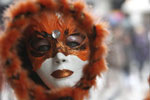Art
The rare red sandal wood
Updated: 2011-02-24 14:48
By Si Xiangnan (Chinaculture.org)
Red sandalwood is one of the most valuable timbers in the world. Native to Southeast Asia, red sandal trees are categorized among evergreen mesophanerophytes. The mature red sandal trees are very tall, but scarce. That is because they need several hundred years to grow thick. When the trunks are thick enough, however, they usually get hollow. The red sandal wood takes on a color of purplish brown, and is so dense that any piece of it placed in water will sink immediately. Even in harsh temperatures and humidity, the wood seldom becomes deformed. That is probably because the tree grows very slow, so its texture is very dense. Though the timber is very hard, it is smooth when cut. This character enables exquisite sculptures be made from it.
 |
The Chinese understanding and use of the red sandal wood can be traced back to the late East Han Dynasty (25-220), but its popularization did not come until the Ming Dynasty (1368-1644). The royalty members of that dynasty valued red sandal wood very much, so they ordered that sandal wood be collected from any possible place for their use. The officials then looked for and cut down red sandal trees extensively at home and abroad. This nearly led to the extinction of mature sandal wood. When time came to the late Ming and early Qing Dynasty (1644-1911), most of the logs and products of red sandalwood around the world had all been stored in China. The extinction of mature wood, resulting from excessive harvesting, makes the red sandal articles priceless today.
 |
Westerners treasure red sandals even more. Before they came to China, they believed that sandal trees were all slender; but afterwards, they were amazed by the big wares made from this timber. Realizing that all excellent works of red sandal wood were in China, westerners purchased a lot of them and got them shipped back to their countries.
Different Categories of Red Sandal Wood
Generally, people call the sandal trees which have bigger leaves “rosewood” and those with smaller leaves “red sandals”. The latter kind, whose veins are hardly seen, is more precious. Renowned varieties of red sandals include cow-hair sandals, chicken-blood sandals and shining-star sandals.
 |
Cow-hair sandals have a fur-like texture. With fine and curvy veins, they are usually made into furniture.
Chicken-blood sandals are rarely seen, and their rich deep red color is their most impressive characteristic. In the sapwood of this kind, there are usually zebra patterns.
Shining-star sandals are the most valuable of all kinds of sandal woods. The shining stars actually refer to the colloid crystallization of the wood fibers. After polishing, the wood will shine like silk in the sunlight, while its color remains an elegant purple-brown.
How to Identify Good Red Sandal Wood
Firstly, the density of red sandals is greater than water. The wood will sink in the water very quickly.
Also, when cut, the inner wood will be found to be redder than its surface. That is because the outer wood will have a deeper color owing to oxidization.
 |
Thirdly, if one rubs alcohol on the wood, its color will also turn deeper.
In addition, the carvings need not to be lacquered on. It will bring out its glossiness again after being buffed.
Lastly, little leaf red sandals give off a fragrance of incense.
Specials

NPC & CPPCC sessions
Lawmakers and political advisers gather in Beijing to discuss major issues.

Self-made aircraft
An automobile mechanic in Northeast China made a test flight of his self-made aircraft which cost about US$395.

Venetian Carnival
Masked revellers celebrate in Saint Mark's Square in Venice.